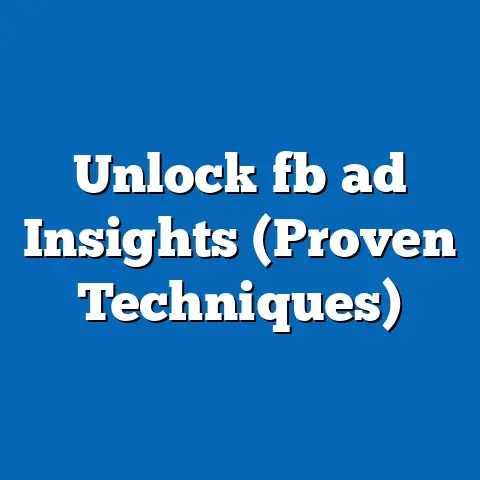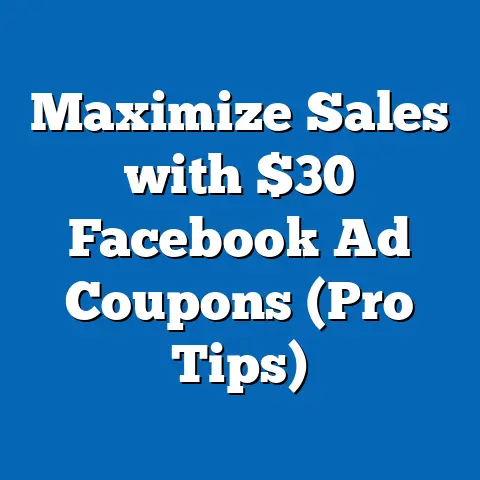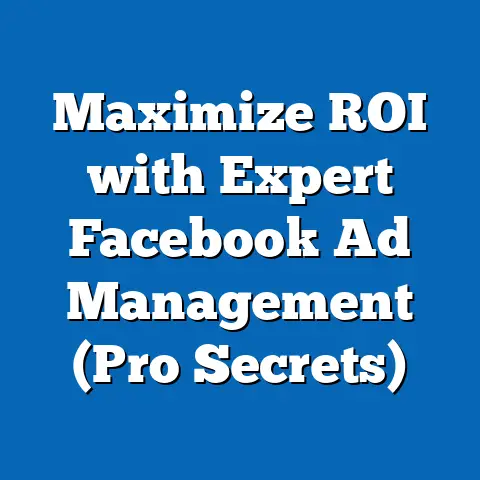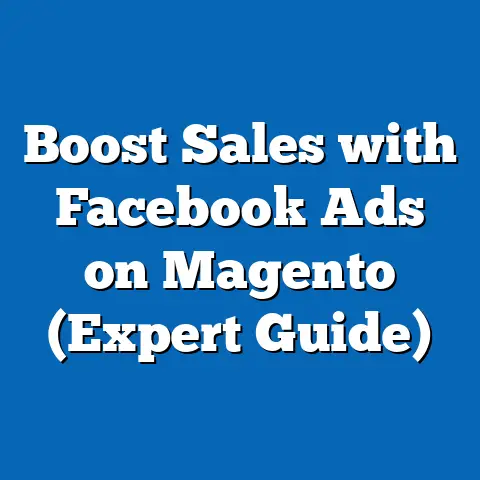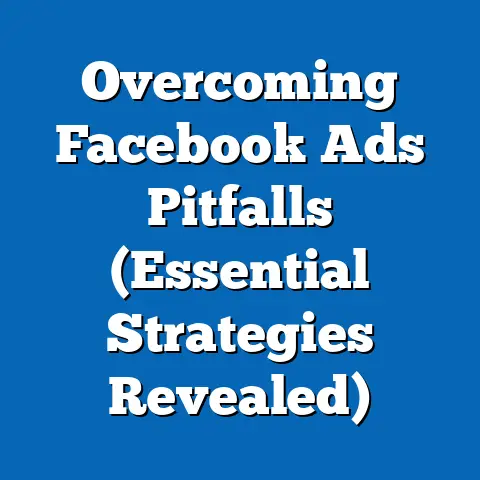Boost App with Facebook Ads (Proven Strategies)
In the ever-evolving world of digital marketing, it’s easy to get caught up in the latest trends and shiny new platforms. But some foundational principles remain timeless, offering consistent results no matter the landscape. One such principle is the power of strategic advertising, and in today’s app-driven world, Facebook Ads stand out as a particularly potent tool. I’ve seen firsthand how a well-crafted Facebook Ads campaign can catapult an app from obscurity to a thriving user base. Whether you’re a seasoned app developer or just starting out, understanding how to leverage Facebook Ads is crucial for success. This article dives deep into proven strategies that can help you boost your app’s visibility, engagement, and downloads, transforming your app from a hidden gem into a market leader.
Understanding Facebook Ads
Facebook Ads, at their core, are advertisements displayed to users on the Facebook platform, including Instagram, Messenger, and the Audience Network. They’re a powerful way to reach a massive audience with targeted messaging. Unlike traditional advertising, Facebook Ads allow for incredibly granular targeting, ensuring your message reaches the people most likely to be interested in your app.
Ad Formats:
- Image Ads: Simple, effective, and visually appealing. They’re great for showcasing your app’s key features or highlighting a specific benefit.
- Video Ads: Highly engaging and perfect for demonstrating your app’s functionality. I’ve found that short, impactful videos often outperform static images.
- Carousel Ads: Allow you to display multiple images or videos in a single ad, perfect for showcasing different aspects of your app or telling a story.
- Story Ads: Immersive and full-screen, these ads are ideal for capturing attention and driving immediate action.
Targeting Capabilities:
The real magic of Facebook Ads lies in its targeting capabilities. Facebook’s vast data collection allows you to target users based on:
- Demographics: Age, gender, location, education, and more.
- Interests: Hobbies, passions, and activities.
- Behaviors: Past purchases, online activity, and app usage.
- Custom Audiences: Uploaded lists of existing customers or website visitors.
- Lookalike Audiences: Users who share similar characteristics with your existing customers.
Facebook Ads Manager:
The Facebook Ads Manager is your command center for creating, managing, and analyzing your campaigns. It provides a comprehensive suite of tools for:
- Setting up campaigns and ad sets.
- Choosing your target audience.
- Selecting your ad format.
- Setting your budget and bidding strategy.
- Tracking your campaign performance.
Takeaway: Facebook Ads offer a versatile platform for reaching a massive, targeted audience with engaging ad formats. The Facebook Ads Manager is your key to unlocking the platform’s full potential.
Setting Clear Objectives for Your App Campaign
Before diving into the technical aspects of Facebook Ads, it’s crucial to define clear and measurable objectives for your campaign. Without a clear goal, you’re essentially throwing money at the wall and hoping something sticks.
Why Objectives Matter:
- Focus Your Efforts: Objectives provide a clear direction for your campaign, guiding your ad creative, targeting, and bidding strategy.
- Measure Success: Measurable objectives allow you to track your progress and determine whether your campaign is achieving its goals.
- Optimize Performance: By understanding what’s working and what’s not, you can make data-driven adjustments to improve your campaign’s performance.
Common Objectives for App Promotions:
- Increase App Installs: The most common objective, focusing on driving downloads of your app.
- Boost In-App Engagement: Encouraging existing users to actively use your app and explore its features.
- Drive User Retention: Reducing churn and ensuring users continue to use your app over time.
- Generate In-App Purchases: Driving revenue by encouraging users to make purchases within your app.
- Increase Brand Awareness: Building recognition and familiarity with your app.
Measurable KPIs (Key Performance Indicators):
- Cost Per Install (CPI): The average cost of acquiring a new user through your ads.
- Click-Through Rate (CTR): The percentage of users who click on your ad.
- Conversion Rate: The percentage of users who complete a desired action (e.g., install the app, make a purchase).
- Return on Ad Spend (ROAS): The revenue generated for every dollar spent on advertising.
- Daily Active Users (DAU): The number of unique users who use your app on a daily basis.
- Monthly Active Users (MAU): The number of unique users who use your app on a monthly basis.
- Retention Rate: The percentage of users who continue to use your app over a specific period.
Example:
Let’s say your objective is to increase app installs. Your measurable KPIs might include CPI (aiming for a CPI below $2) and conversion rate (striving for a 10% conversion rate from ad click to app install).
Takeaway: Define clear and measurable objectives before launching your Facebook Ads campaign. These objectives will guide your strategy and allow you to track your progress effectively. I’ve seen campaigns with unclear objectives fail miserably, while those with well-defined goals consistently outperform.
Crafting Compelling Ad Creative
Your ad creative is the face of your campaign. It’s the first impression you make on potential users, and it can make or break your success. Compelling ad creative grabs attention, communicates value, and motivates action.
Best Practices for Designing Visuals:
- Use High-Quality Images and Videos: Blurry or pixelated visuals will instantly turn users off.
- Showcase Your App’s Best Features: Highlight the most compelling aspects of your app.
- Keep it Simple and Clean: Avoid clutter and focus on a clear message.
- Use Colors that Pop: Eye-catching colors can help your ad stand out in a crowded newsfeed.
- Optimize for Mobile: Ensure your visuals look great on mobile devices, where most users will be seeing them.
Writing Compelling Copy:
- Highlight Benefits, Not Just Features: Focus on how your app will improve users’ lives.
- Use Strong Action Words: Encourage users to take action with words like “Download Now,” “Get Started,” or “Learn More.”
- Keep it Concise and Engaging: Get to the point quickly and use language that resonates with your target audience.
- Personalize Your Message: Tailor your copy to the specific interests and needs of your target audience.
- Use Emojis Strategically: Emojis can add personality and visual appeal to your copy.
Incorporating Strong Calls-to-Action (CTAs):
- Make it Clear What You Want Users to Do: Use clear and direct CTAs that leave no room for ambiguity.
- Use Button CTAs: Button CTAs are more visually prominent and tend to generate higher click-through rates.
- Test Different CTAs: Experiment with different CTAs to see what resonates best with your audience.
A/B Testing Ad Creatives:
A/B testing involves creating multiple versions of your ad creative and testing them against each other to see which performs best. This is a crucial step in optimizing your campaign.
- Test One Element at a Time: To accurately measure the impact of each change, test only one element at a time (e.g., headline, image, CTA).
- Use Facebook’s A/B Testing Tool: The Facebook Ads Manager provides built-in A/B testing tools to simplify the process.
- Analyze the Results and Iterate: Based on the results of your A/B tests, refine your ad creative and continue testing.
Examples of Successful Ad Creatives:
- Headspace: Their ads often feature calming visuals and focus on the benefits of mindfulness and meditation.
- Duolingo: Their ads use playful characters and highlight the ease and fun of learning a new language.
- Airbnb: Their ads showcase stunning destinations and emphasize the unique experiences available through their platform.
Takeaway: Crafting compelling ad creative is essential for capturing attention and driving action. Focus on creating high-quality visuals, writing engaging copy, and incorporating strong CTAs. I always emphasize the importance of A/B testing; it’s the key to continuously improving your ad performance.
Targeting the Right Audience
Even the most compelling ad creative will fall flat if it’s shown to the wrong audience. Facebook’s targeting capabilities allow you to reach the people most likely to be interested in your app, maximizing your ROI.
Targeting Options:
- Demographic Targeting: Target users based on age, gender, location, education, relationship status, and more.
- Interest-Based Targeting: Target users based on their interests, hobbies, and activities. This is a powerful way to reach people who are passionate about specific topics related to your app.
- Behavioral Targeting: Target users based on their past purchases, online activity, and app usage. This allows you to reach people who have demonstrated an interest in similar apps or products.
- Custom Audiences: Upload lists of existing customers or website visitors to create custom audiences. This is a great way to re-engage existing users or target people who have already shown interest in your app.
- Lookalike Audiences: Create lookalike audiences to reach potential users who share similar characteristics with your existing customers. This is one of the most effective targeting strategies for expanding your reach and acquiring new users.
Using Lookalike Audiences:
Lookalike audiences are a game-changer. Facebook analyzes your existing customer data (e.g., email list, website visitors) and identifies common characteristics and behaviors. It then finds other Facebook users who share those same characteristics, creating a highly targeted audience of potential new customers.
- Start with a High-Quality Source Audience: The more accurate and representative your source audience, the better your lookalike audience will be.
- Experiment with Different Lookalike Sizes: Facebook allows you to create lookalike audiences of varying sizes, ranging from 1% to 10% of the total population in a given country. Smaller audiences are more similar to your source audience, while larger audiences offer broader reach.
- Test Different Lookalike Audiences: Create multiple lookalike audiences based on different source audiences (e.g., website visitors, paying customers) and test them against each other.
Continuous Audience Analysis and Refinement:
Targeting is not a “set it and forget it” process. You need to continuously analyze your audience performance and refine your targeting strategy based on the data.
- Monitor Your Audience Demographics: Track which demographics are responding best to your ads.
- Analyze Your Audience Interests: Identify which interests are driving the most conversions.
- Refine Your Targeting Based on Performance: Exclude underperforming demographics and interests and focus on those that are delivering the best results.
Takeaway: Targeting the right audience is crucial for maximizing your ROI. Leverage Facebook’s granular targeting options, including lookalike audiences, and continuously analyze your audience performance to refine your strategy. I’ve seen campaigns that were initially struggling completely turn around simply by optimizing their targeting.
Budgeting and Bidding Strategies
Setting the right budget and choosing the right bidding strategy are essential for maximizing your ROI and achieving your campaign objectives.
Budgeting Options:
- Daily Budget: Set a fixed amount that you’re willing to spend each day. This is a good option for campaigns that run continuously.
- Lifetime Budget: Set a total amount that you’re willing to spend over the entire duration of your campaign. This is a good option for campaigns with a specific end date.
Bidding Strategies:
- Cost-Per-Click (CPC): You pay each time someone clicks on your ad. This is a good option for driving traffic to your app store page.
- Cost-Per-Impression (CPM): You pay for every 1,000 impressions your ad receives. This is a good option for increasing brand awareness.
- Cost-Per-Action (CPA): You pay only when someone takes a specific action, such as installing your app. This is the most performance-driven bidding strategy.
- Lowest Cost: Facebook automatically bids to get you the most results for your budget. This is a good option for beginners.
- Target Cost: You set a target cost per result, and Facebook tries to achieve that target. This is a good option for campaigns with specific performance goals.
Determining the Right Budget:
- Start Small and Scale Up: Begin with a small budget and gradually increase it as you see positive results.
- Consider Your Target Audience Size: The larger your target audience, the larger your budget will need to be.
- Factor in Your CPI Goals: Determine how much you’re willing to pay for each app install and set your budget accordingly.
- Monitor Your Campaign Performance: Continuously monitor your campaign performance and adjust your budget as needed.
Takeaway: Choose the budgeting option and bidding strategy that best align with your campaign objectives. Start small, monitor your performance, and adjust your budget as needed. I’ve found that a data-driven approach to budgeting and bidding is crucial for maximizing ROI.
Analyzing Campaign Performance
Monitoring and analyzing your campaign performance is essential for understanding what’s working and what’s not, and making data-driven adjustments to improve your results.
Key Metrics to Track:
- Click-Through Rate (CTR): The percentage of users who click on your ad. A high CTR indicates that your ad is relevant and engaging.
- Conversion Rate: The percentage of users who complete a desired action (e.g., install the app, make a purchase). A high conversion rate indicates that your ad is effectively driving results.
- Cost Per Install (CPI): The average cost of acquiring a new user through your ads. A low CPI indicates that your campaign is cost-effective.
- Return on Ad Spend (ROAS): The revenue generated for every dollar spent on advertising. A high ROAS indicates that your campaign is profitable.
- Daily Active Users (DAU): The number of unique users who use your app on a daily basis.
- Monthly Active Users (MAU): The number of unique users who use your app on a monthly basis.
- Retention Rate: The percentage of users who continue to use your app over a specific period.
Using Facebook Ads Manager to Monitor Performance:
The Facebook Ads Manager provides a comprehensive dashboard for monitoring your campaign performance. You can track all of the key metrics mentioned above, as well as a variety of other data points.
- Customize Your Columns: Customize the columns in your Ads Manager to display the metrics that are most important to you.
- Use Filters and Breakdowns: Use filters and breakdowns to segment your data and identify trends. For example, you can filter your data by age, gender, or location to see which demographics are responding best to your ads.
- Create Custom Reports: Create custom reports to track your campaign performance over time.
Interpreting Data and Making Informed Decisions:
- Identify Trends: Look for patterns in your data and identify trends that can inform your strategy.
- Compare Performance Across Ad Sets: Compare the performance of different ad sets to see which targeting options are delivering the best results.
- A/B Test and Iterate: Continuously A/B test different ad creatives, targeting options, and bidding strategies to improve your campaign performance.
Takeaway: Regularly monitor and analyze your campaign performance using the Facebook Ads Manager. Interpret the data and make informed decisions to optimize your campaign and achieve your objectives. I always tell my clients, “The data tells a story; listen to it.”
Conclusion
Facebook Ads offer a powerful and versatile platform for boosting app visibility, engagement, and downloads. By understanding the fundamentals of Facebook Ads, setting clear objectives, crafting compelling ad creative, targeting the right audience, and analyzing your campaign performance, you can unlock the platform’s full potential and achieve your app promotion goals.
The strategies outlined in this article are not just fleeting trends; they’re timeless principles that remain effective regardless of the latest algorithm update or platform change. These are the foundational elements that I’ve seen drive consistent results time and time again.
Now it’s your turn. Start experimenting with Facebook Ads, apply these proven strategies, and track your results. Share your experiences and insights with the community, and let’s all learn and grow together. The world of app marketing is constantly evolving, but with a solid foundation and a commitment to continuous learning, you can achieve lasting success.

